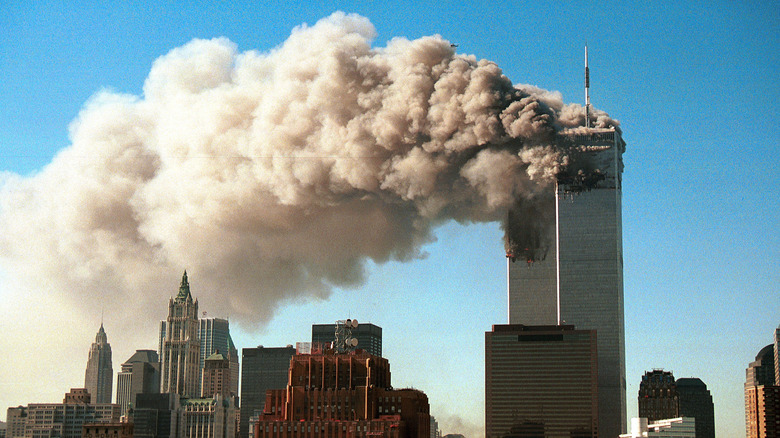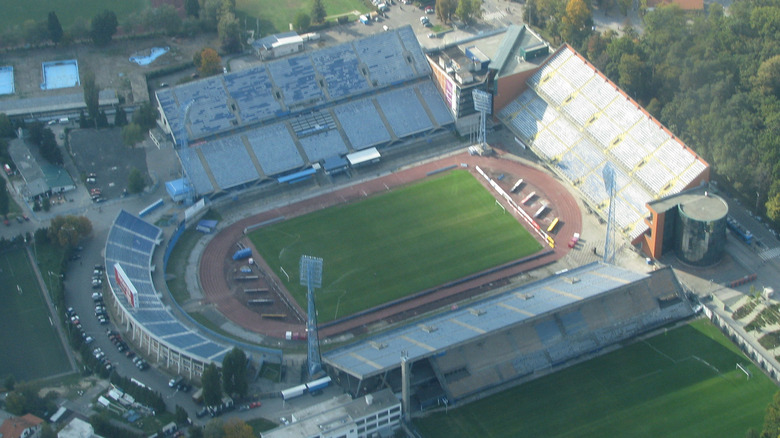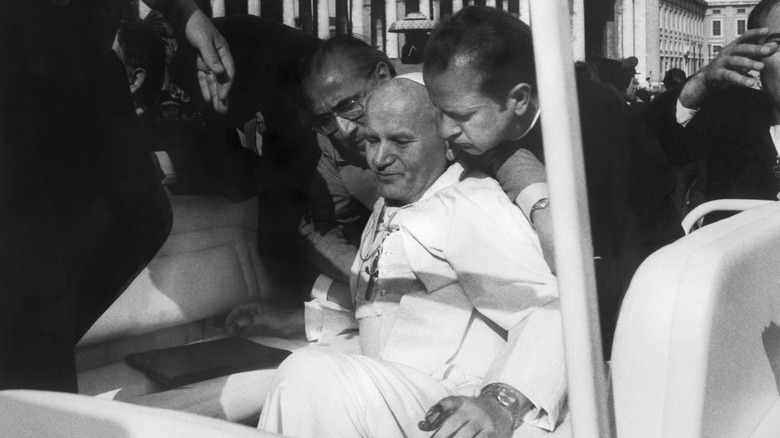Devastating Tragedies Caught On Live TV
When one reads about a tragedy, be it in a paper or a book, it is easy to feel detached from it, as if the event and the people that die are just statistics and facts. But when that tragedy is caught on film, particularly from a first-person perspective — think a news crew or the citizen journalist with a cell phone — things look very different.
The late 20th and early 21st centuries have introduced the world to the digital age, and with that, the ability to see natural disasters and other tragic events up close in raw, unedited footage. One can read about a plane crashing into the Twin Towers on 9/11, but it is quite a different matter watching the raw footage filmed from a New York City street. Here are some of the worst tragedies that have been caught on live TV and their consequences, some of which are still felt today.
The 1990 Dinamo-Red Star Riot
Ranking high among the wildest fan fights of sports history, the Dinamo-Red Star riot occurred as Yugoslavia disintegrated amid ethnic rivalries in the late 1980s. Towards the end of the 1989-90 Yugoslav soccer season, one of the biggest and most violent soccer rivalries in the world met at the Croatian capital's Maksimir Stadium (pictured), where Serbian side Red Star Belgrade played faced off Dinamo Zagreb. That year, Croatian pro-independence parties had won a massive electoral victory, and police expected trouble between the hardcore nationalist fans.
Croatian fan and eyewitness Ivo Persa told a Trans World Sport documentary team the riot began when Red Star fans attacked the Dinamo family section. In response, Dinamo's ultras — the Bad Blue Boys — counterattacked, igniting a full-scale riot involving everything from rocks, seats, knives, and even acid. Police responded with tear gas and batons. The Croatian fans accused the police of favoring the Serbs and also attacked them. Dinamo player Zvonimir Boban then kicked a police officer in the face for beating a Dinamo fan. By the end, over 60 were wounded.
Croatian journalist Dusan Kruselj told Trans World Sport the riot was likely pre-planned by the authorities in Belgrade. He noted that notorious Serbian paramilitary and politician, Zeljko "Arkan" Raznatovic, who would later commit war crimes in Croatia and Bosnia, was present there as head of the Red Star fans. Regardless, May 13, 1990, lives in Croatian lore as the beginning of the Croatian War of Independence, with Boban's kick being the opening shot.
[Featured image by Suradnik13 via Wikimedia Commons | Cropped and scaled | CC BY-SA 4.0]
Palm Sunday Church Bombing
The Arab Spring, a series of revolutions against authoritarian governments in the Middle East, saw former Egyptian President Hosni Mubarak deposed and replaced with an Islamist government under Mohammed Morsi and the Muslim Brotherhood. The latter's tenure ignited a steep increase in terror attacks against the country's sizable Coptic Christian minority. After Morsi's 2013 ouster, attacks intensified, including a 2013 siege of St. Mark's Cathedral in Cairo and a 2016 bomb attack at the same location, among others.
In 2017, the world witnessed twin bombings in the northern cities of Tanta and Alexandria on Palm Sunday – one week before Easter. The Tanta bombing at St. George's Coptic Church was caught on YouTube livestream. As the camera is fixed on the choir, the bomb goes off and the feed cuts, leaving only the sound of screaming. The attack killed 28 and wounded 77.
Egyptian security forces concluded that a suicide bomber had managed to get through security because the metal detector was not working. The attack was linked to militants of the terror group ISIS, which claimed credit for the bombing as an attack against Christian crusaders and apostates. Egyptian President Abdel-Fattah el-Sisi condemned the attack, along with another bombing in Alexandria, and issued a three-month state of emergency. Thirty-one were arrested in connection to the bombing, while another 17 were at large when the Egyptian government remanded them to military court in 2017.
The attempted assassination of Pope John Paul II
Nearly losing his life during World War II, Pope John Paul II was saved by a friend and Soviet soldier. On May 13, 1981, the pontiff had another close brush with death, which occurred as he was riding through St. Peter's Square to receive and bless the crowds who had come to see him. Suddenly, two shots rang out, hitting the pope and a fellow tourist. The pontiff slumped down in his car as his security detail rushed him to hospital.
The recordings captured the crowd's utter state of shock, with people screaming and crying at what had just transpired. David DePerro, who witnessed the assassination attempt close-up, told the Catholic News Agency that the crowd quickly subdued the assassin, but lost his film and photos to Italian police, who confiscated everything.
The shooter was a young Turkish man named Mehmet Ali Agca, who testified to an Italian court that the U.S.S.R. put him up to the task, although there were at leasts seven others from Bulgaria and Turkey who were also charged with involvement. This was not a surprise – the Polish-born pontiff was an implacable foe of communism, whose election sent Moscow into a state of panic. Nevertheless, the pope forgave Agca, even visiting him in prison, something Rev. Federico Lombardi called "the most important image of mercy [he had] seen in [his] life." Agca eventually converted to Catholicism in 2007.
1986 Challenger Explosion
On January 28, 1986, Americans were glued to their televisions to watch the latest space shuttle launch – that of the Challenger. The launch was supposed to kick off a busy year for NASA in preparation for the launch of the Hubble Space Telescope. The Challenger would deploy satellites while also carrying a teacher named Christa McAuliffe, who would teach her classes from space. The Challenger appeared to be adhering to the timeline when it launched successfully, but around one minute into the flight, it exploded in midair, killing the entire crew.
After delivering a eulogy in honor of the crew, President Ronald Reagan ordered an investigation into the explosion, whose findings were summarized in the Rogers Commission Report. The Commission found "the loss of the Space Shuttle Challenger was caused by a failure in the joint between the two lower segments of the right Solid Rocket Motor. The specific failure was the destruction of the seals that are intended to prevent hot gases from leaking..." – in other words, a technical failure that was likely preventable, but was not caught due to NASA's command structure.
According to the Rogers Report, the maker of the seals on the shuttle's launcher had warned NASA that they could potentially fail in colder weather. Morton Thiokol, the company in question, issued the warning as early as 1985, but it seems that NASA decided to go through with the launch anyway, despite colder temperatures being predicted for Cape Canaveral on the launch date, which was in early winter.
2012 Boston Marathon Bombing
The finish line of a marathon, especially a world-class one like Boston, is supposed to be a place of joy where runners celebrate their achievement. In 2012, however, it became the scene of carnage when someone detonated two bombs near the finish line. Three people were killed and another 260 injured. President Barack Obama declared a manhunt as federal forces were marshaled to find the perpetrators.
Eventually, security footage led to a young Chechen student named Dzhokhar Tsarnaev and his older brother, Tamerlan. The two brothers responded by killing an MIT security guard. Despite having enough weapons to carry out another massacre, they did not for whatever reason, opting instead to try and flee so they could conduct a similar attack in New York City's Times Square. Before they could arrive, Tamerlan was killed in a firefight, while the wounded Dzhokhar managed to hide out in a boat before federal agents arrested him. In a subsequent interrogation, Dzhokhar reportedly told federal agents the attacks were vengeance for the U.S. occupations of various Muslim countries.
Dzhokhar was convicted for the bombing and sentenced to death by lethal injection, which the Supreme Court upheld. But in 2024, Tsarnaev's lawyers alleged that holding the trial in Boston, and seating two jurors who allegedly lied on the questionnaire, made it impossible for their client to get justice. The case is pending review as of mid-2024.
1989 World Series Earthquake
The 1989 World Series was known as the "Battle of the Bay," pitting NorCal sides the San Francisco Giants and the Oakland A's in America's baseball showpiece. Oakland won the first two, so San Francisco needed to win game three to have a chance at forcing a tiebreaker in a fifth game. During ABC's pre-game coverage of the third game, however, the screen suddenly cut out.
Despite the ABC announcers' optimism that coverage would return, the situation was far more serious than they made it seem: San Francisco had been hit by a 6.9 magnitude earthquake. The tremor cut power to the stadium, and forced the game to be postponed 10 days. Nor was the city left untouched.
For a 15-second earthquake, the 1989 Loma Prieta tremor did way more than just interrupt the World Series. According to the statistics from the California Department of Conservation, the earthquake caused around $10 billion in damage and economic interruption. Nearly 18,000 homes were damaged and nearly 1,000 destroyed, as were thousands of small businesses. Part of Interstate 880 collapsed, leaving the highway unusable, while the Bay Bridge connecting Oakland with San Francisco was also closed. Sixty-seven were killed and 3,700 injured. As for the World Series, play resumed 10 days later, as Oakland swept the series with a four-game triumph.
1992 Los Angeles Riots
Counting among the worst instances of mass civil violence in U.S. history, the 1992 Los Angeles riots began in response to the acquittal of four police officers who were accused of beating a Black man named Rodney King due to his skin color. Los Angeles was engulfed in looting and violence that saw 50 killed, around 2,300 injured, and a staggering $1 billion in property damage.
In the period leading up to the riots, South Los Angeles was a tinderbox of racially charged resentment, directed in no small part against the LAPD, who were seen by the majority-Black residents as more of an occupying force than peacekeepers. In Koreatown, the recent shooting of a 16-year-old girl by a storeowner had exacerbated tensions between Korean and Black residents, fanning the flames that eventually rose. Black street gangs targeted white and Hispanic residents, stores were looted, and general mayhem reigned. As video cameras captured the Los Angeles skyline ablaze, reporters noted that there was little that could be done to contain the problem – the LA police, who were already short-staffed before the riots, were simply spread too thin to effectively control the chaos.
The governor of California, Pete Wilson, ultimately was forced to call in the state national guard, which managed to contain the worst of the rioting. The guard's presence, combined with Rodney King's appeal for calm and for Angelenos to try and get along, helped the rioting eventually subside.
The 9/11 terrorist attacks
Pretty much the seminal event and tragedy of 21st-century America, 9/11 was one of those events without which life and the world would be very different had it not occurred. On that day, two planes flew into the World Trade Center towers in downtown New York City, the first of which was captured in a chilling video filmed just blocks away from the towers. In addition, one aircraft hit the Pentagon, and another crashed into a Pennsylvania field, seemingly on its way to another target in Washington, D.C. Altogether, 2997 people were killed.
After the United States identified Al-Qaeda terror group leader Osama Bin Laden as the mastermind behind the attacks, President George W. Bush declared the infamous "Global War on Terror." To accomplish this, Congress and the Bush administration ratified the 2001 Authorization for Use of Military Force, whose language was so vague, it gave the White House a virtual blank check to involve the United States in virtually any country on the excuse of fighting terrorism, leading to the Afghan War and bombing campaigns against at least six other countries.
At home, the United States experienced an unprecedented curtailing of civil liberties thanks to the Patriot Act, which allowed the U.S. government to warrantlessly collect phone records, emails, bank records, credit records, and more. Anything outside of these categories could be seized if it was believed to be in any way related to terrorism.
Notre-Dame de Paris fire
Notre-Dame de Paris, medieval Christendom's most famous cathedral, is a proud symbol of France that took centuries to build. Yet, it was all wiped out in one day in a tragic fire that hit the cathedral in the spring of 2019. Live footage captured the tragic yet iconic moment in which the spire collapsed in a blaze, leaving onlookers stunned.
Investigators concluded the most likely cause of the fire was an electrical short circuit, as the cathedral had been undergoing maintenance and renovations. Although numerous irreplaceable works of art were destroyed, not everything was a tragedy. A French firefighter saved one of the cathedral's most prized possessions – a relic believed to be a piece of the Crown of Thorns Jesus wore during his Crucifixion.
The tragedy united people worldwide – Catholic and non-Christian alike – to rebuild the cathedral, with France collecting around $1 billion from individual and corporate donors for its restoration. However, there was the question as to how exactly the cathedral should be rebuilt. Initially, there were all sorts of plans, from rebuilding it as it was to partially converting it into a solar-urban farm for Paris' homeless or a giant greenhouse. In the end, the French government, which owns the cathedral and gets the final say, has opted to rebuild it exactly as it was.
2004 Indian Ocean Tsunami
The 2004 Indian Ocean tsunami, which ranks among the worst tsunamis in history, struck a handful of countries in the Asia-Pacific region, battering Thailand, the Philippines, Sri Lanka, and especially the Indonesian island of Sumatra. Witnesses who filmed the tragedy in Thailand captured 20-foot-tall waves. But these were small potatoes compared to what happened in Indonesia, where Sumatra suffered waves as high as 167 feet that flooded up to three miles inland.
The tsunami was the result of a 9.1 magnitude earthquake in the Indian Ocean, which was felt across the Indian Subcontinent all the way to Somalia in East Africa (the highest ever-recorded earthquake is 9.5). Once the tsunami formed, it slammed into the coastlines, carrying away entire communities forever. It was so violent that entire shorelines were submerged, while in other places, the sea actually receded, leaving parts of the ocean floor above water. All in all, it left around 225,000 dead, displaced 1.7 million, and caused $13 billion in damage – not including the revenue losses many of the Southeast Asian tourist economies faced after the disaster.
Interestingly, one place survived mostly intact. North Sentinel Island, a small Indian-ruled part of the Andaman Archipelago, was mostly submerged. However, the North Sentinelese inhabitants, who eschew all contact with the outside world, survived, perhaps retreating to higher ground before the worst struck.
The Grenfell Tower fire
In June 2019, the inhabitants of West London woke up to a horrifying site at 1 a.m.: the 23-storey Grenfell Apartment Council Complex had caught fire and was fiercely ablaze. Grenfell inhabitant Behailu Kebede called the London Fire Brigade, which found smoke and fire at Kebede's window near a fridge-freezer, perhaps as a result of what the brigade called "unknown materials" (via BBC). The blaze quickly spread around the window, eventually engulfing the whole building.
What was particularly scary about the fire was that although it began on the fourth floor – one of the lower floors – it was not contained, and residents on the upper floors soon found themselves facing flames moving up the building. Therein lay the cause of most of the casualties. Grenfell's policy required residents in a fire to stay put in their homes because the building was ostensibly designed to ensure fires were contained in a single apartment. That did not happen, meaning that many people who obeyed the "stay put" order were burned alive, while those who survived were the ones who defied it.
Altogether, 72 people were killed. The local council demanded an investigation into why the fire had spread so easily, despite the alleged safety features of the building. It found that the council itself had cut corners on fire safety design and silenced anyone who objected.


